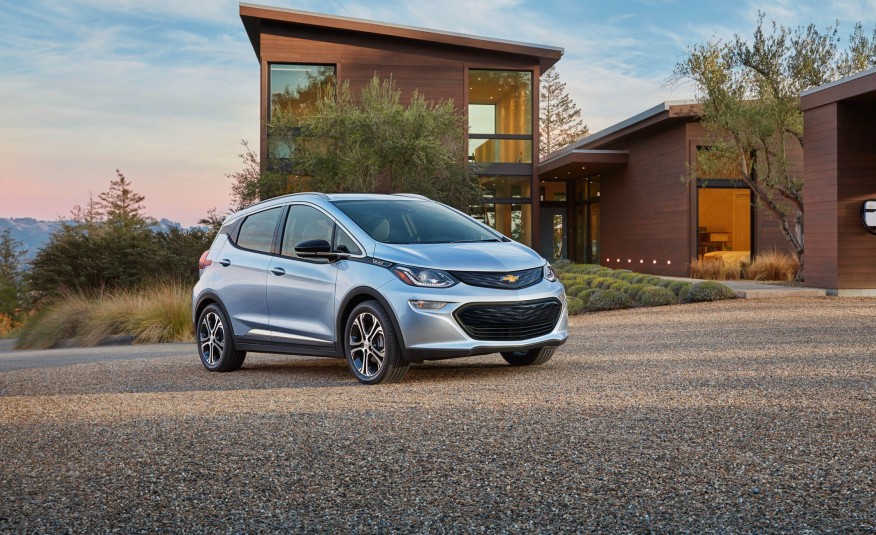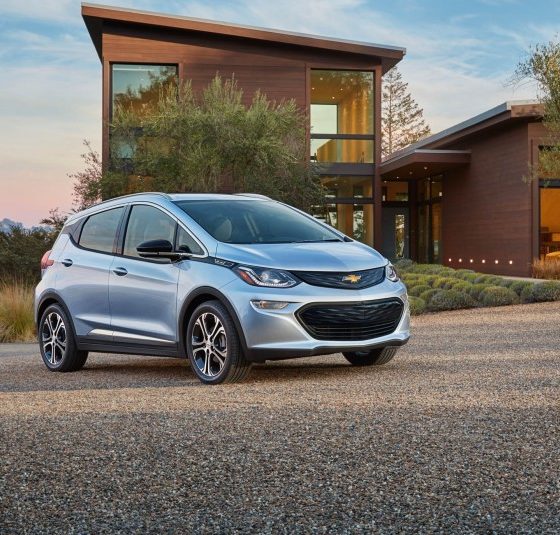General Motors announced that battery production for the Chevy Bolt EV is once again underway. Battery production resumed on Monday, the automaker said, and outlined a course of action to “ensure that customers can safely and confidently drive, charge, and park the Chevy Bolt EV and EUV.”
Over the past twelve months, the Bolt EV has had three recalls related to battery issues that have caused combustion in some instances. During the July recall, the second related to battery problems, GM announced that “the simultaneous presence of two rare manufacturing defects in the same battery cell” caused an increased risk of battery fires. The recall affected around 69,000 cars worldwide.
GM then doubled down on the recall in late August, announcing that it had temporarily halted production of the Bolt altogether. GM spokesman Daniel Flores commented:
“We will not resume repairs or restart production until we are confident LG is producing defect-free products for us.”
As of now, manufacturing of the Bolt EV has not resumed, only the production of the battery cells that the vehicle utilizes.
The recalls set GM back around $1.8 billion so far this year and led to a widespread case of paranoia among those who saw the vehicles on the road. A parking lot in San Francisco actually prohibited Bolt EVs from parking at their facility due to the battery issues.
Now, GM has announced that production has resumed for Bolt EV batteries. Due to an updated manufacturing process and new advanced diagnostics software from GM, there is now confidence from the Detroit-based automaker that the worst of the issues are now behind them. “We’re grateful for the patience of owners and dealers as we work to advance solutions to this recall,” GM Executive VP of Global Product Development, Purchasing and Supply Chain, Doug Parks, said. “Resuming battery module production is a first step and we’ll continue to work aggressively with LG to obtain additional battery supply. In addition, we’re optimistic a new advanced diagnostic software will provide more convenience for our customers.”
The Bolt EV utilizes cells from battery supplier LG, which operates cell production plants in Holland and Michigan. Both facilities have resumed production and replacement battery modules will be shipped to dealers “as soon as mid-October,” the company said. LG has worked with GM to initiate and implement a new plan of attack that will recognize and identify defects in battery cells, providing confidence in the batteries moving forward.
How the Chevy Bolt EV became GM’s 1.8 billion dollar problem
In terms of the replacement process of the affected population, GM said it will “continue to prioritize Chevy Bolt EV and EUV customers whose batteries were manufactured during specific build timeframes where GM believes battery defects appear to be clustered. The company has established a notification process that will inform affected customers when their replacement modules will be available.” The new batteries will include an extended warranty as well: 8-year/100,000-mile limited warranty (8-year/160,000 km limited warranty in Canada).
Additionally, GM will launch a new advanced diagnostic software that will roll out within approximately 60 days. The software will detect specific abnormalities that might indicate a damaged or defective battery in either the Bolt EV or EUV, alerting customers of abnormalities. GM plans to allow owners to return to 100% state of charge once diagnostic processes are completed. For now, the company states that owners should do the following:
- Set the vehicle to a 90 percent state of charge limitation using Target Charge Level mode. Instructions on how to do this are available on chevy.com/boltevrecall. If customers are unable to successfully make these changes or do not feel comfortable making these changes, GM is asking them to visit their dealer to have these adjustments completed.
- Charge the vehicle more frequently and avoid depleting battery below approximately 70 miles (113 km) of remaining range, where possible.
- Continue to park vehicles outside immediately after charging and do not leave vehicles charging indoors overnight.

Elon Musk
Elon Musk and Tesla AI Director share insights after empty driver seat Robotaxi rides
The executives’ unoccupied tests hint at the rapid progress of Tesla’s unsupervised Robotaxi efforts.

Tesla CEO Elon Musk and AI Director Ashok Elluswamy celebrated Christmas Eve by sharing personal experiences with Robotaxi vehicles that had no safety monitor or occupant in the driver’s seat. Musk described the system’s “perfect driving” around Austin, while Elluswamy posted video from the back seat, calling it “an amazing experience.”
The executives’ unoccupied tests hint at the rapid progress of Tesla’s unsupervised Robotaxi efforts.
Elon and Ashok’s firsthand Robotaxi insights
Prior to Musk and the Tesla AI Director’s posts, sightings of unmanned Teslas navigating public roads were widely shared on social media. One such vehicle was spotted in Austin, Texas, which Elon Musk acknowleged by stating that “Testing is underway with no occupants in the car.”
Based on his Christmas Eve post, Musk seemed to have tested an unmanned Tesla himself. “A Tesla with no safety monitor in the car and me sitting in the passenger seat took me all around Austin on Sunday with perfect driving,” Musk wrote in his post.
Elluswamy responded with a 2-minute video showing himself in the rear of an unmanned Tesla. The video featured the vehicle’s empty front seats, as well as its smooth handling through real-world traffic. He captioned his video with the words, “It’s an amazing experience!”
Towards Unsupervised operations
During an xAI Hackathon earlier this month, Elon Musk mentioned that Tesla owed be removing Safety Monitors from its Robotaxis in Austin in just three weeks. “Unsupervised is pretty much solved at this point. So there will be Tesla Robotaxis operating in Austin with no one in them. Not even anyone in the passenger seat in about three weeks,” he said. Musk echoed similar estimates at the 2025 Annual Shareholder Meeting and the Q3 2025 earnings call.
Considering the insights that were posted Musk and Elluswamy, it does appear that Tesla is working hard towards operating its Robotaxis with no safety monitors. This is quite impressive considering that the service was launched just earlier this year.
Elon Musk
Starlink passes 9 million active customers just weeks after hitting 8 million
The milestone highlights the accelerating growth of Starlink, which has now been adding over 20,000 new users per day.

SpaceX’s Starlink satellite internet service has continued its rapid global expansion, surpassing 9 million active customers just weeks after crossing the 8 million mark.
The milestone highlights the accelerating growth of Starlink, which has now been adding over 20,000 new users per day.
9 million customers
In a post on X, SpaceX stated that Starlink now serves over 9 million active users across 155 countries, territories, and markets. The company reached 8 million customers in early November, meaning it added roughly 1 million subscribers in under seven weeks, or about 21,275 new users on average per day.
“Starlink is connecting more than 9M active customers with high-speed internet across 155 countries, territories, and many other markets,” Starlink wrote in a post on its official X account. SpaceX President Gwynne Shotwell also celebrated the milestone on X. “A huge thank you to all of our customers and congrats to the Starlink team for such an incredible product,” she wrote.
That growth rate reflects both rising demand for broadband in underserved regions and Starlink’s expanding satellite constellation, which now includes more than 9,000 low-Earth-orbit satellites designed to deliver high-speed, low-latency internet worldwide.
Starlink’s momentum
Starlink’s momentum has been building up. SpaceX reported 4.6 million Starlink customers in December 2024, followed by 7 million by August 2025, and 8 million customers in November. Independent data also suggests Starlink usage is rising sharply, with Cloudflare reporting that global web traffic from Starlink users more than doubled in 2025, as noted in an Insider report.
Starlink’s momentum is increasingly tied to SpaceX’s broader financial outlook. Elon Musk has said the satellite network is “by far” the company’s largest revenue driver, and reports suggest SpaceX may be positioning itself for an initial public offering as soon as next year, with valuations estimated as high as $1.5 trillion. Musk has also suggested in the past that Starlink could have its own IPO in the future.
News
NVIDIA Director of Robotics: Tesla FSD v14 is the first AI to pass the “Physical Turing Test”
After testing FSD v14, Fan stated that his experience with FSD felt magical at first, but it soon started to feel like a routine.

NVIDIA Director of Robotics Jim Fan has praised Tesla’s Full Self-Driving (Supervised) v14 as the first AI to pass what he described as a “Physical Turing Test.”
After testing FSD v14, Fan stated that his experience with FSD felt magical at first, but it soon started to feel like a routine. And just like smartphones today, removing it now would “actively hurt.”
Jim Fan’s hands-on FSD v14 impressions
Fan, a leading researcher in embodied AI who is currently solving Physical AI at NVIDIA and spearheading the company’s Project GR00T initiative, noted that he actually was late to the Tesla game. He was, however, one of the first to try out FSD v14.
“I was very late to own a Tesla but among the earliest to try out FSD v14. It’s perhaps the first time I experience an AI that passes the Physical Turing Test: after a long day at work, you press a button, lay back, and couldn’t tell if a neural net or a human drove you home,” Fan wrote in a post on X.
Fan added: “Despite knowing exactly how robot learning works, I still find it magical watching the steering wheel turn by itself. First it feels surreal, next it becomes routine. Then, like the smartphone, taking it away actively hurts. This is how humanity gets rewired and glued to god-like technologies.”
The Physical Turing Test
The original Turing Test was conceived by Alan Turing in 1950, and it was aimed at determining if a machine could exhibit behavior that is equivalent to or indistinguishable from a human. By focusing on text-based conversations, the original Turing Test set a high bar for natural language processing and machine learning.
This test has been passed by today’s large language models. However, the capability to converse in a humanlike manner is a completely different challenge from performing real-world problem-solving or physical interactions. Thus, Fan introduced the Physical Turing Test, which challenges AI systems to demonstrate intelligence through physical actions.
Based on Fan’s comments, Tesla has demonstrated these intelligent physical actions with FSD v14. Elon Musk agreed with the NVIDIA executive, stating in a post on X that with FSD v14, “you can sense the sentience maturing.” Musk also praised Tesla AI, calling it the best “real-world AI” today.










